Effect of Recycled Aggregate Carrying Sulfate Corrosion Media on Drying and Autogenous Shrinkage of Mortar
Abstract
:1. Introduction
2. Materials and Experiment
2.1. Materials and Mix Proportions
2.2. Specimens
2.3. Testing Method
2.3.1. Drying and Autogenous Shrinkages of Mortar Tests
2.3.2. SEM and XRD tests
3. Results and Discussion
3.1. Effect of the RS Replacement Percentage on the Shrinkage of Mortar
3.2. Effect of the W/C on the Shrinkage of Mortar
3.3. Effect of the Secondary Cementitious Materials on the Shrinkage of Mortar
3.4. Effect of the RS Corrosion Concentration on the Shrinkage of Mortar
3.5. XRD Analysis
3.6. SEM Analysis
4. Conclusions
Author Contributions
Funding
Data Availability Statement
Conflicts of Interest
References
- Development Status Analysis and Market Forecast Forecast Report of China’s Construction Waste Treatment Industry from 2019 to China Industry Research; China Industry Research: Beijing, China, 2019.
- Lotfi, S.; Eggimann, M.; Wagner, E.; Mróz, R.; Deja, J. Performance of recycled aggregate concrete based on a new concrete recycling technology. Constr. Build. Mater. 2015, 95, 243–256. [Google Scholar] [CrossRef]
- Wang, L.; Wang, J.; Qian, X.; Chen, P.; Xu, Y.; Guo, J. An environmentally friendly method to improve the quality of recycled concrete aggregates. Constr. Build. Mater. 2017, 144, 432–441. [Google Scholar] [CrossRef] [Green Version]
- Bravo, M.; De Brito, J.; Pontes, J.; Evangelista, L. Durability performance of concrete with recycled aggregates from construction and demolition waste plants. Constr. Build. Mater. 2015, 77, 357–369. [Google Scholar] [CrossRef]
- Silva, R.V.; De Brito, J.; Dhir, R.K. Properties and composition of recycled aggregates from construction and demolition waste suitable for concrete production. Constr. Build. Mater. 2014, 65, 201–217. [Google Scholar] [CrossRef]
- Katz, A. Properties of concrete made with recycled aggregate from partially hydrated old concrete. Cem. Concr. Res. 2003, 33, 703–711. [Google Scholar] [CrossRef]
- Martín-Morales, M.; Zamorano, M.; Ruiz-Moyano, A.; Valverde-Espinosa, I. Characterization of recycled aggregates construction and demolition waste for concrete production following the Spanish Structural Concrete Code EHE-08. Constr. Build. Mater. 2011, 25, 742–748. [Google Scholar] [CrossRef]
- Akbarnezhad, A.; Ong, K.; Zhang, M.; Tam, C.; Foo, T. Microwave-assisted beneficiation of recycled concrete aggregates. Constr. Build. Mater. 2011, 25, 3469–3479. [Google Scholar] [CrossRef]
- Ismail, S.; Ramli, M. Engineering properties of treated recycled concrete aggregate (RCA) for structural applications. Constr. Build. Mater. 2013, 44, 464–476. [Google Scholar] [CrossRef]
- Kou, S.-C.; Poon, C.S. Properties of concrete prepared with PVA-impregnated recycled concrete aggregates. Cem. Concr. Compos. 2010, 32, 649–654. [Google Scholar] [CrossRef]
- Qiu, J.; Tng, D.Q.S.; Yang, E.-H. Surface treatment of recycled concrete aggregates through microbial carbonate precipitation. Constr. Build. Mater. 2014, 57, 144–150. [Google Scholar] [CrossRef]
- Singh, L.P.; Bisht, V.; Aswathy, M.S.; Chaurasia, L.; Gupta, S. Studies on performance enhancement of recycled aggregate by incorporating bio and nano materials. Constr. Build. Mater. 2018, 181, 217–226. [Google Scholar] [CrossRef]
- Xie, J.H.; Guo, Y.C.; Liu, L.S.; Xie, Z.H. Compressive and flexural behaviours of a new steel-fibre-reinforced recycled aggregate concrete with crumb rubber. Constr. Build. Mater. 2015, 15, 263–272. [Google Scholar] [CrossRef]
- Kou, S.-C.; Poon, C.S. Effect of the quality of parent concrete on the properties of high performance recycled aggregate concrete. Constr. Build. Mater. 2015, 77, 501–508. [Google Scholar] [CrossRef]
- McGinnis, M.J.; Davis, M.; de la Rosa, A.; Weldon, B.D.; Kurama, Y.C. Strength and stiffness of concrete with recycled concrete aggregates. Constr. Build. Mater. 2017, 154, 258–269. [Google Scholar] [CrossRef]
- Pedro, D.; de Brito, J.; Evangelista, L. Structural concrete with simultaneous incorporation of fine and coarse recycled concrete aggregates: Mechanical, durability and long-term properties. Constr. Build. Mater. 2017, 154, 294–309. [Google Scholar] [CrossRef]
- Xiao, J.; Li, L.; Shen, L.; Poon, C.S. Compressive behaviour of recycled aggregate concrete under impact loading. Cem. Concr. Res. 2015, 71, 46–55. [Google Scholar] [CrossRef]
- Paz, S.S.; González-Fonteboa, B.; Martínez-Abella, F.; Eiras-López, J. Flexural performance of reinforced concrete beams made with recycled concrete coarse aggregate. Eng. Struct. 2018, 156, 32–45. [Google Scholar] [CrossRef]
- Pedro, D.; de Brito, J.; Evangelista, L. Influence of the use of recycled concrete aggregates from different sources on structural concrete. Constr. Build. Mater. 2014, 71, 141–151. [Google Scholar] [CrossRef]
- Zega, C.; Dos Santos, G.C.; Villagrán-Zaccardi, Y.; Di Maio, A. Performance of recycled concretes exposed to sulphate soil for 10 years. Constr. Build. Mater. 2016, 102, 714–721. [Google Scholar] [CrossRef]
- Bui, N.K.; Satomi, T.; Takahashi, H. Mechanical properties of concrete containing 100% treated coarse recycled concrete aggregate. Constr. Build. Mater. 2018, 163, 496–507. [Google Scholar] [CrossRef]
- Tam, V.W.Y.; Tam, C.M.; Le, K.N. Removal of cement mortar remains from recycled aggregate using pre-soaking approaches. Resour. Conserv. Recycl. 2007, 50, 82–101. [Google Scholar] [CrossRef] [Green Version]
- Bui, N.K.; Satomi, T.; Takahashi, H. Improvement of mechanical properties of recycled aggregate concrete basing on a new combination method between recycled aggregate and natural aggregate. Constr. Build. Mater. 2017, 148, 376–385. [Google Scholar] [CrossRef]
- Xuan, D.; Zhan, B.; Poon, C.S. Assessment of mechanical properties of concrete incorporating carbonated recycled concrete aggregates. Cem. Concr. Compos. 2016, 65, 67–74. [Google Scholar] [CrossRef]
- Bravo, M.; de Brito, J.; Evangelista, L.; Pacheco, J. Durability and shrinkage of concrete with CDW as recycled aggregates: Benefits from superplasticizer’s incorporation and influence of CDW composition. Constr. Build. Mater. 2018, 168, 818–830. [Google Scholar] [CrossRef]
- Pedro, D.; de Brito, J.; Evangelista, L. Evaluation of high-performance concrete with recycled aggregates: Use of densified silica fume as cement replacement. Constr. Build. Mater. 2017, 147, 803–814. [Google Scholar] [CrossRef]
- Bendimerad, A.Z.; Rozière, E.; Loukili, A. Plastic shrinkage and cracking risk of recycled aggregates concrete. Constr. Build. Mater. 2016, 121, 733–745. [Google Scholar] [CrossRef]
- Tian, Y.; Yan, X.; Zhang, M.; Lu, D.; Yang, T.; Wang, Z.; Li, W. Internal transport and corrosion behaviors of sulfate corrosion media carried by recycled aggregate in concrete. Constr. Build. Mater. 2020, 260, 120480. [Google Scholar] [CrossRef]
- Paz, S.S.; González-Fonteboa, B.; Martínez-Abella, F.; González-Taboada, I. Time-dependent behaviour of structural concrete made with recycled coarse aggregates. Creep Shrinkage. Constr. Build. Mater. 2016, 122, 95–109. [Google Scholar] [CrossRef]
- Zhang, H.; Wang, Y.-Y.; Lehman, D.E.; Geng, Y. Autogenous-shrinkage model for concrete with coarse and fine recycled aggregate. Cem. Concr. Compos. 2020, 111, 103600. [Google Scholar] [CrossRef]
- Domingo-Cabo, A.; Lázaro, C.; López-Gayarre, F.; Serrano-López, M.A.; Serna, P.; Castaño-Tabares, J.O. Creep and shrinkage of recycled aggregate concrete. Constr. Build. Mater. 2009, 23, 2545–2553. [Google Scholar] [CrossRef]
- Domingo, A.; Lázaro, C.; Gayarre, F.L.; Serrano, M.A.; López-Colina, C. Long term deformations by creep and shrinkage in recycled aggregate concrete. Mater. Struct. 2009, 43, 1147–1160. [Google Scholar] [CrossRef]
- Gómez Soberón, J.M.V. Sinkage of concrete with replacement of aggregate with recycled concrete aggregate. In Proceedings of the ACI Fifth International Conference on Innovations in Design with Emphasis on Seismic, Wind, and Environmental Loading; Quality Control and Innovations in Materials/Hot Weather Concreting, Cancun, Mexico, 1 January 2002; Available online: http://hdl.handle.net/2117/2559 (accessed on 16 September 2021).
- Gonzalez-Corominas, A.; Etxeberria, M. Effects of using recycled concrete aggregates on the shrinkage of high performance concrete. Constr. Build. Mater. 2016, 115, 32–41. [Google Scholar] [CrossRef]
- Gholampour, A.; Ozbakkaloglu, T. Time-dependent and long-term mechanical properties of concretes incorporating different grades of coarse recycled concrete aggregates. Eng. Struct. 2018, 157, 224–234. [Google Scholar] [CrossRef]
- Rao, G. Long-term drying shrinkage of mortar—Influence of silica fume and size of fine aggregate. Cem. Concr. Res. 2001, 31, 171–175. [Google Scholar] [CrossRef]
- Nežerka, V.; Havlásek, P.; Trejbal, J. Mitigating inclusion-induced shrinkage cracking in cementitious composites by incorporating recycled concrete fines. Constr. Build. Mater. 2020, 248, 118673. [Google Scholar] [CrossRef]
- Shariq, M.; Prasad, J.; Abbas, H. Creep and drying shrinkage of concrete containing GGBFS. Cem. Concr. Compos. 2016, 68, 35–45. [Google Scholar] [CrossRef]
- Yousefieh, N.; Joshaghani, A.; Hajibandeh, E.; Shekarchizadeh, M. Influence of fibers on drying shrinkage in restrained concrete. Constr. Build. Mater. 2017, 148, 833–845. [Google Scholar] [CrossRef]
- Shen, D.; Wen, C.; Zhu, P.; Wu, Y.; Yuan, J. Influence of Barchip fiber on early-age autogenous shrinkage of high strength concrete. Constr. Build. Mater. 2020, 256, 119223. [Google Scholar] [CrossRef]
- Saiz-Martínez, P.; Ferrández-Vega, D.; Morón-Fernández, C.; De Tejada-Alonso, A.P. Comparative study of the influence of three types of fibre in the shrinkage of recycled mortar. Mater. Construcción 2018, 68, 168. [Google Scholar] [CrossRef]
- Kanema, J.M.; Eid, J.; Taibi, S. Shrinkage of earth concrete amended with recycled aggregates and superplasticizer: Impact on mechanical properties and cracks. Mater. Des. 2016, 109, 378–389. [Google Scholar] [CrossRef]
- Souche, J.-C.; Bendimerad, A.Z.; Roziere, E.; Salgues, M.; Devillers, P.; Garcia-Diaz, E.; Loukili, A. Early age behaviour of recycled concrete aggregates under normal and severe drying conditions. J. Build. Eng. 2017, 13, 244–253. [Google Scholar] [CrossRef]
- Li, T.; Zhu, P.T.; Zhang, B.; Ding, K.L.; Sun, Z.M. Experimental study on corrosion rection-diffusion process of concrete under sulfate attack. Bull. Chin. Ceram. Soc. 2020, 39, 50–55. [Google Scholar] [CrossRef]
- Bulatović, V.; Melešev, M.; Radeka, M.; Radonjanin, V.; Lukić, I. Evaluation of sulfate resistance of concrete with recycled and natural aggregates. Constr. Build. Mater. 2017, 152, 614–631. [Google Scholar] [CrossRef]
- GB/T 50082-Standard for Test Methods of Long-Term Performance and Durability of Ordinary Concrete; Ministry of Housing and Urban-Rural Development: Beijing, China, 2009.
- Liu, T.; Qin, S.; Zou, D.; Song, W. Experimental investigation on the durability performances of concrete using cathode ray tube glass as fine aggregate under chloride ion penetration or sulfate attack. Constr. Build. Mater. 2018, 163, 634–642. [Google Scholar] [CrossRef]
- Butler, L.; West, J.S.; Tighe, S.L. Effect of recycled concrete coarse aggregate from multiple sources on the hardened properties of concrete with equivalent compressive strength. Constr. Build. Mater. 2013, 47, 1292–1301. [Google Scholar] [CrossRef]
- Dapena, E.; Alaejos, P.; Lobet, A.; Pérez, D. Effect of recycled sand content on characteristics of mortars and concretes. J. Mater. Civ. Eng. 2011, 23, 414–422. [Google Scholar] [CrossRef]
- Liao, Y. Chemical shrinkage and electrical resistivity of cement at early age. J. Huazhong Univ. Sci. Technol. 2012, 40, 29–33. [Google Scholar]
- Ming, A.N.; Zhu, J.; Qin, W. Autogenous shrinkage of high performance concrete. J. Build. Mater. 2001, 4, 159–166. [Google Scholar]
- Bellmann, F.; Möser, B.; Stark, J. Influence of sulfate solution concentration on the formation of gypsum in sulfate resistance test specimen. Cem. Concr. Res. 2006, 36, 358–363. [Google Scholar] [CrossRef]
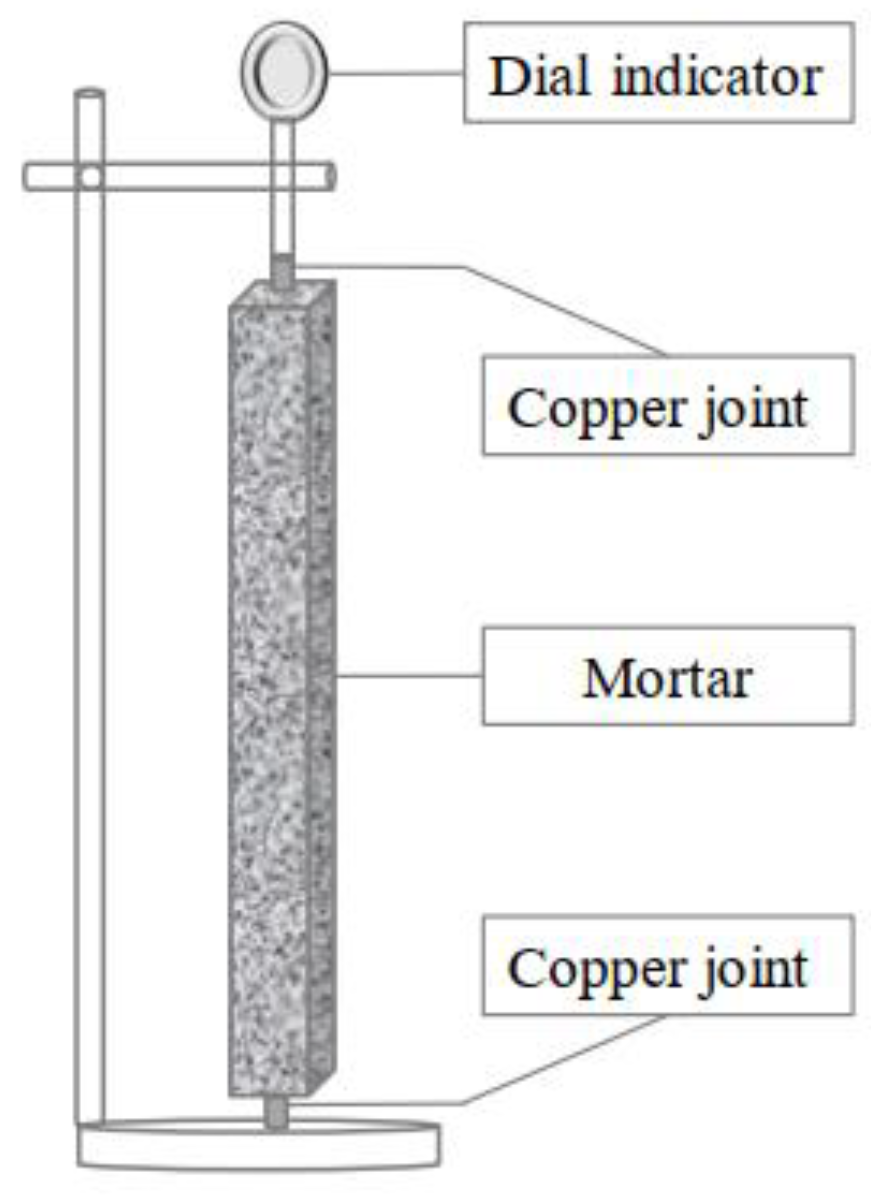
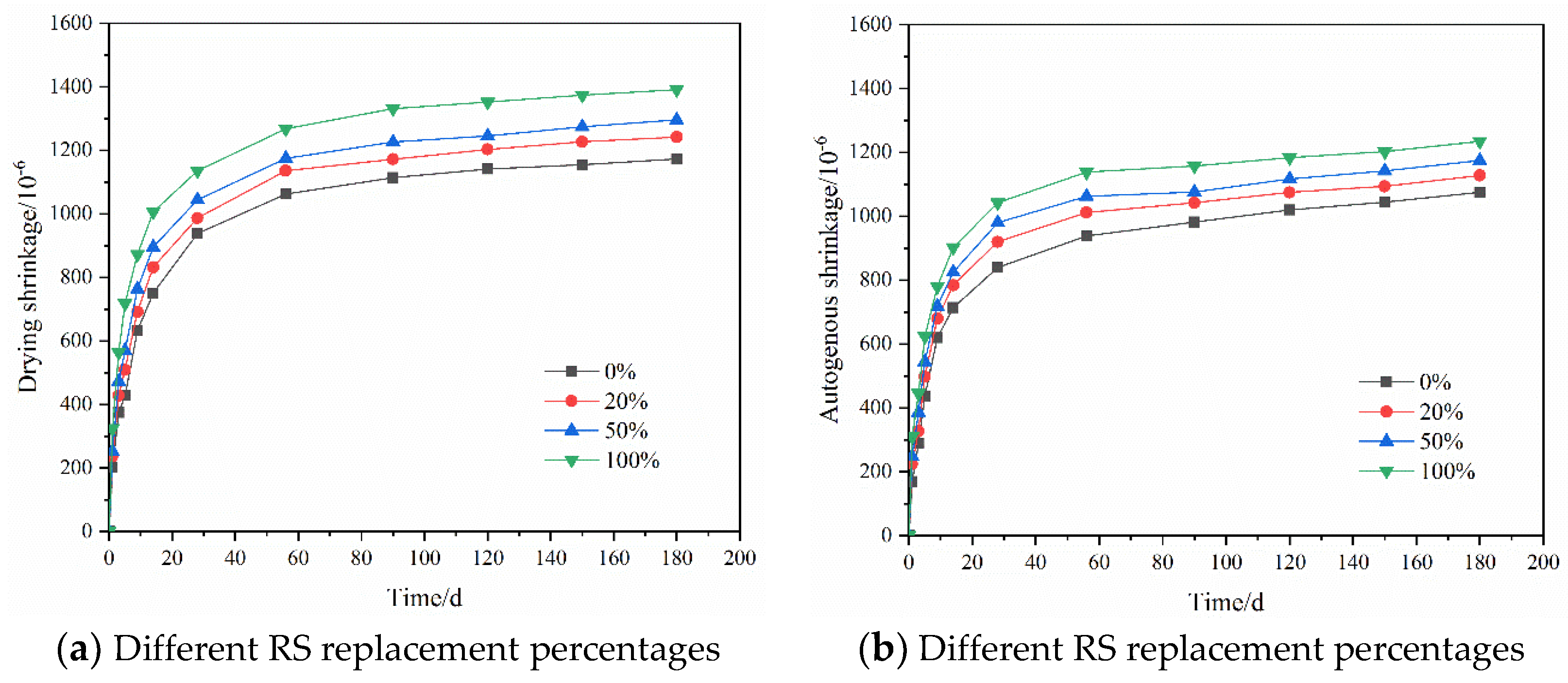
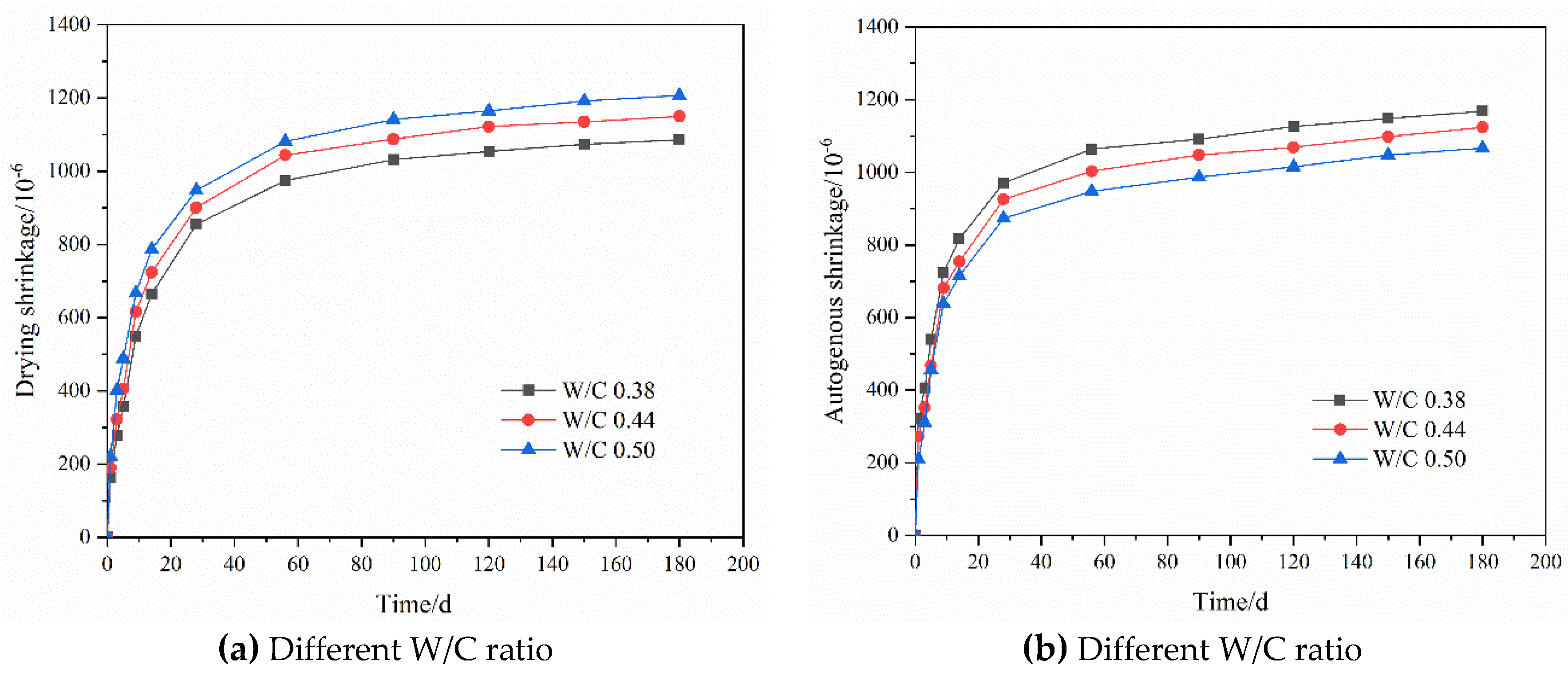
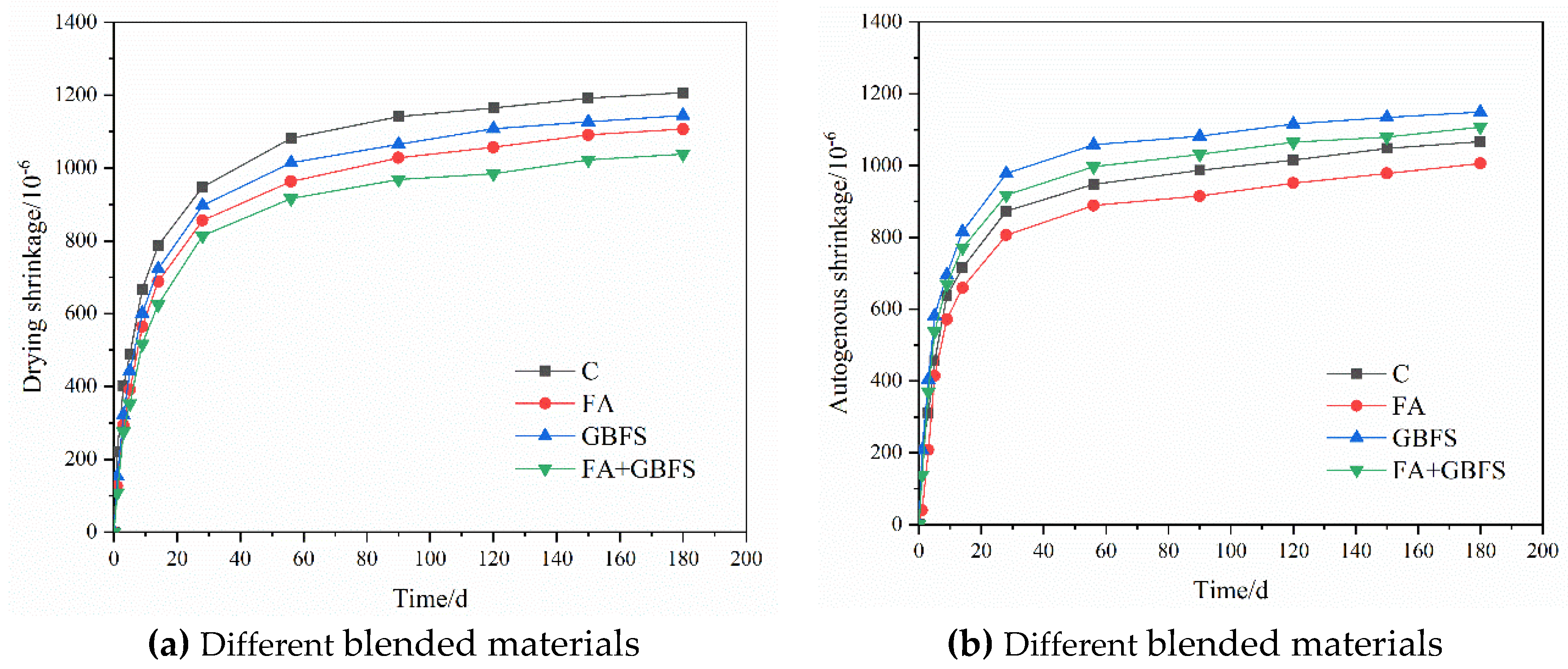
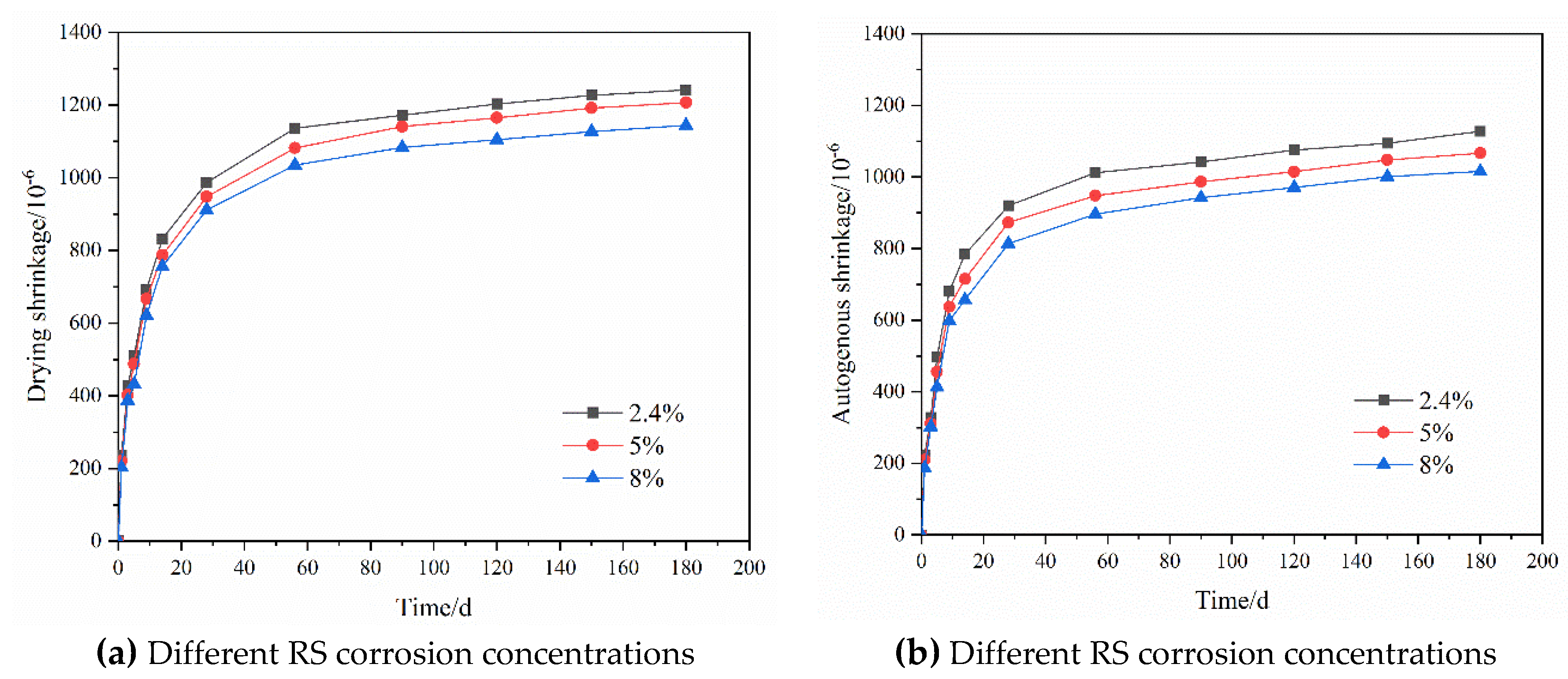
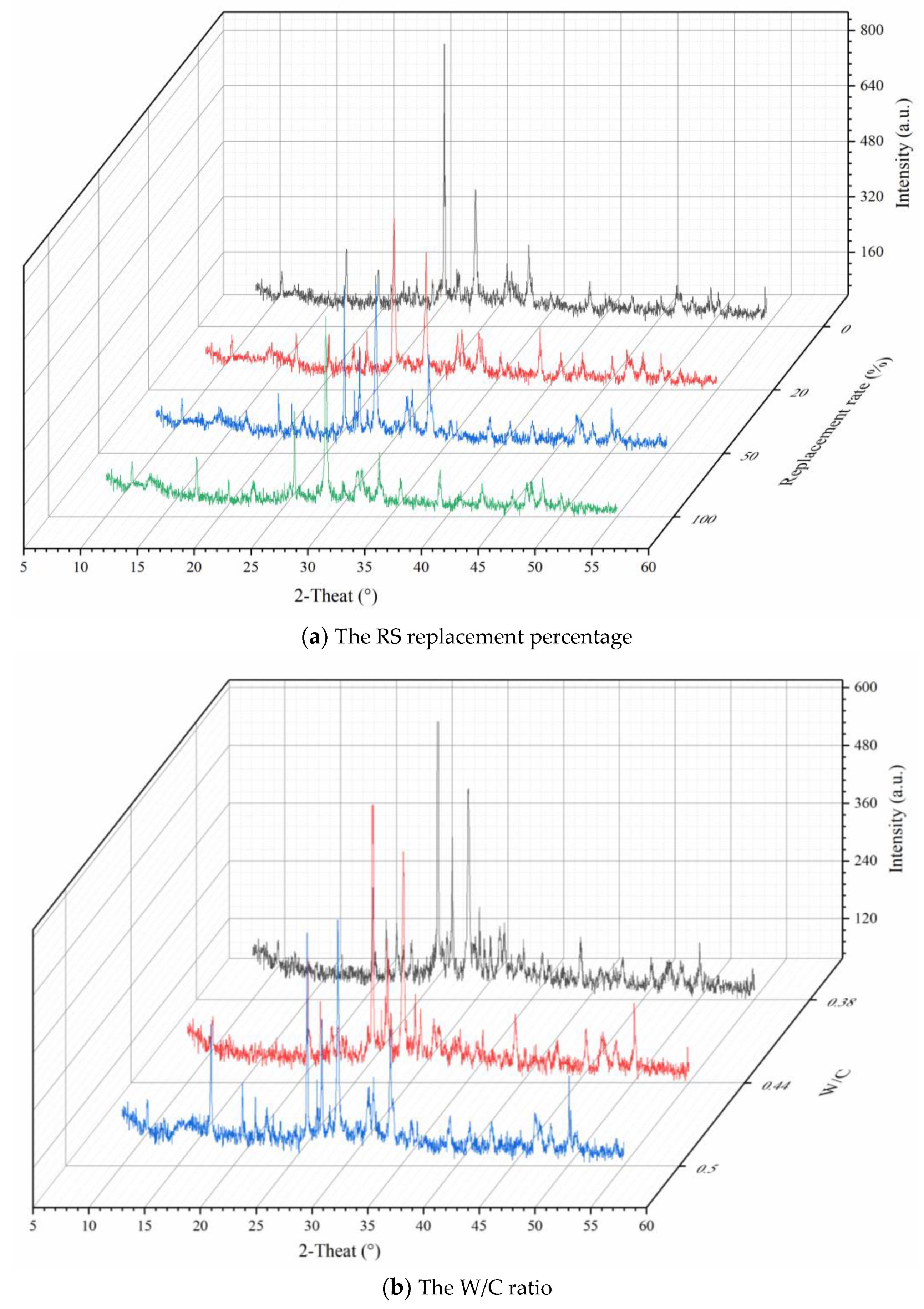
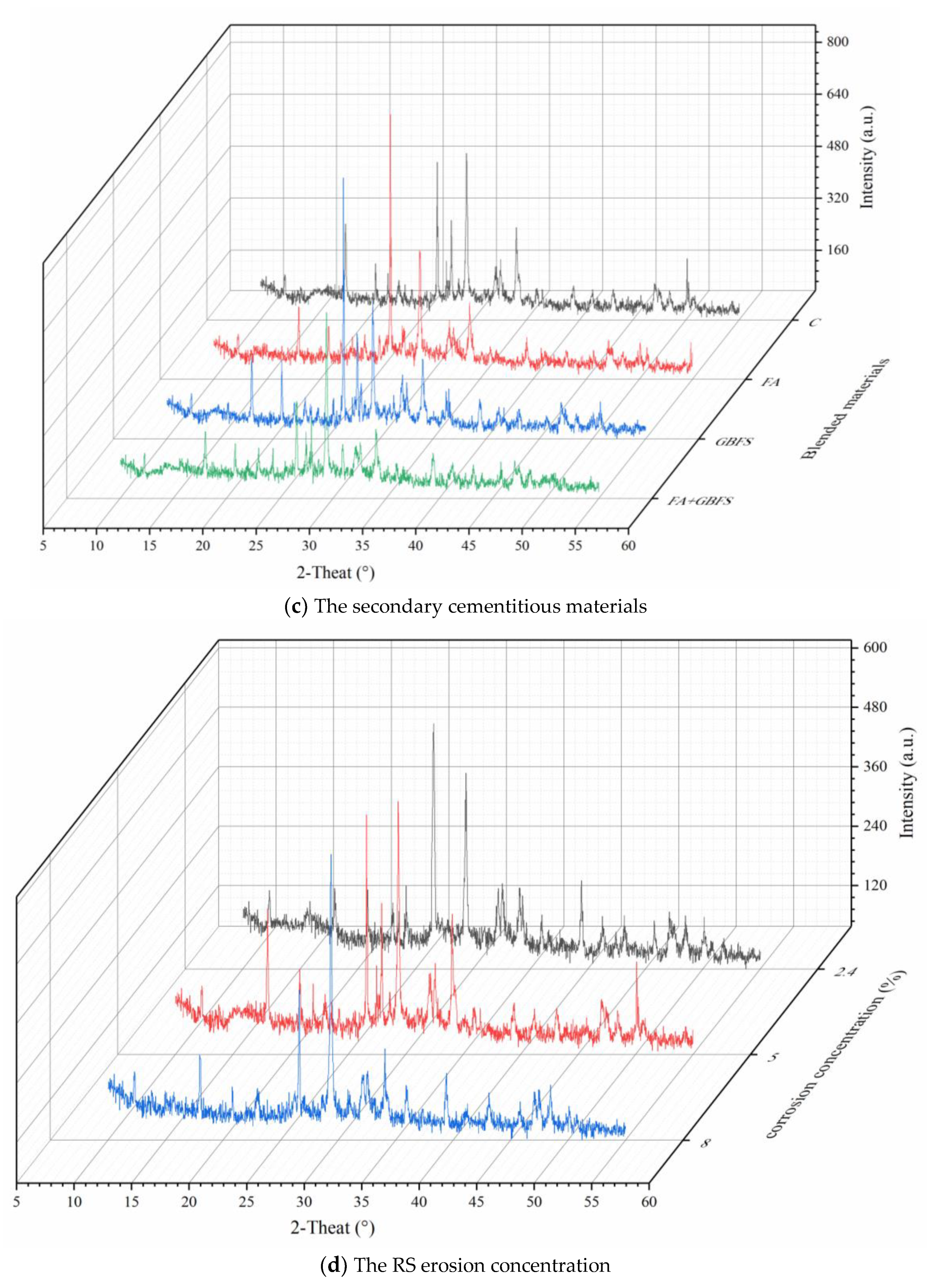
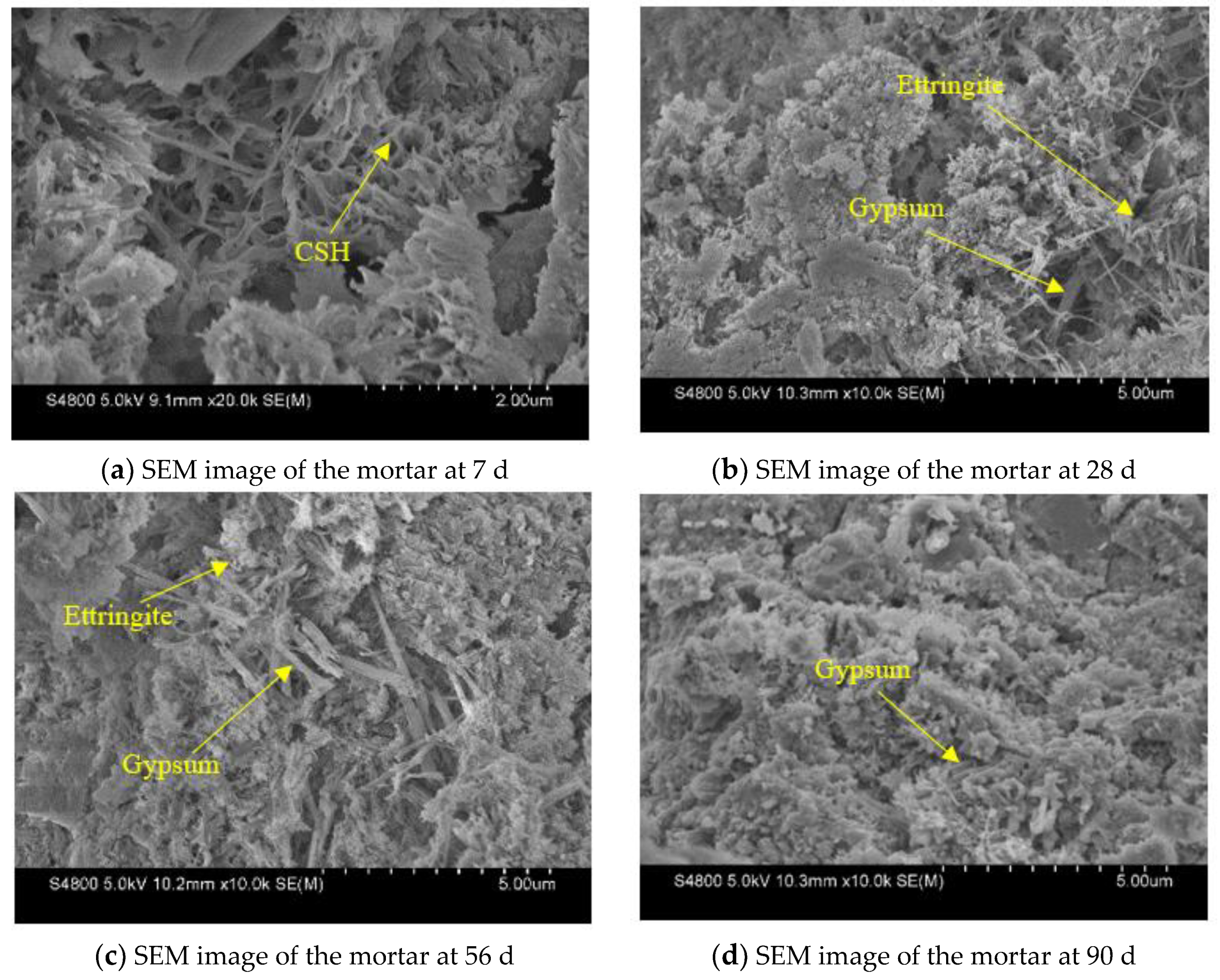
| Compression Strength (MPa) 3 d 28 d | Flexural Strength (MPa) 3 d 28 d | Setting Time (min) Initial Final Condensation Condensation | Specific Surface Area (m2/kg) | Standard Consistency (%) | |||
|---|---|---|---|---|---|---|---|
| 19.1 | 46.8 | 3.8 | 6.8 | 248 | 301 | 350 | 25.6 |
| Aggregate Type | Porosity (%) | Bulk Density (kg/m3) | Water Absorption (%) | Crushing Index (%) |
|---|---|---|---|---|
| NS | 32.5 | 2730 | 1.13 | 7.8 |
| RS | 41.2 | 2510 | 4.63 | 15.2 |
| Chemical Compositions | SiO2 | Al2O3 | CaO | Fe2O3 | K2O | MgO | SO3 |
|---|---|---|---|---|---|---|---|
| Percentage (%) | 50.35 | 33.18 | 0.63 | 6.39 | 0.86 | 1.15 | 1.03 |
| Chemical Compositions | SiO2 | Al2O3 | CaO | Fe2O3 | K2O | MgO | SO3 |
|---|---|---|---|---|---|---|---|
| Percentage (%) | 32.5 | 13.50 | 41.90 | 0.80 | 0.60 | 6.9 | 1.83 |
| No. | Replacement Percentage (%) | Design of Mix Proportion (kg/m3) | ||||||
|---|---|---|---|---|---|---|---|---|
| Water | Cement | NS | RS | FA | GBFS | SP | ||
| A-0 | 0 | 230 | 460 | 1128 | 0 | 0 | 0 | 5.5 |
| A-1 | 20 | 230 | 460 | 902 | 226 | 0 | 0 | 5.5 |
| A-2 | 50 | 230 | 460 | 564 | 564 | 0 | 0 | 5.5 |
| A-3 | 100 | 230 | 460 | 0 | 1128 | 0 | 0 | 5.5 |
| B-1 | 20 | 175 | 460 | 902 | 226 | 0 | 0 | 5.5 |
| B-2 | 20 | 202 | 460 | 902 | 226 | 0 | 0 | 5.5 |
| B-3 | 20 | 230 | 460 | 902 | 226 | 0 | 0 | 5.5 |
| C-1 | 20 | 230 | 460 | 902 | 226 | 0 | 0 | 5.5 |
| C-2 | 20 | 230 | 414 | 902 | 226 | 0 | 46 | 5.5 |
| C-3 | 20 | 230 | 322 | 902 | 226 | 138 | 0 | 5.5 |
| C-4 | 20 | 230 | 276 | 902 | 226 | 138 | 46 | 5.5 |
| D-1 | 20 | 230 | 460 | 902 | 226 | 0 | 0 | 5.5 |
| D-2 | 20 | 230 | 460 | 902 | 226 | 0 | 0 | 5.5 |
| D-3 | 20 | 230 | 460 | 902 | 226 | 0 | 0 | 5.5 |
| No. | Replacement Percentage | W/C | Secondary Cementitious Materials | Erosion Concentration |
|---|---|---|---|---|
| A-0 A-1 A-2 A-3 | 0% 20% 50% 100% | 0.5 0.5 0.5 0.5 | C + NS C + NS + RS C + NS + RS C + RS | 0 2.4% 2.4% 2.4% |
| B-1 B-2 B-3 | 20% 20% 20% | 0.38 0.44 0.5 | C + NS + RS C + NS + RS C + NS + RS | 5% 5% 5% |
| C-1 C-2 C-3 C-4 | 20% 20% 20% 20% | 0.5 0.5 0.5 0.5 | C + NS + RS C + NS + RS + 10%GBFS C + NS + RS + 30%FA C + NS + RS + 10%GBFS + 30%FA | 5% 5% 5% 5% |
| D-1 D-2 D-3 | 20% 20% 20% | 0.5 0.5 0.5 | C + NS + RS C + NS + RS C + NS + RS | 2.4% 5% 8% |
| t (d) | 1 | 3 | 5 | 9 | 14 | 28 | 56 | 90 | 120 | 150 | 180 | Average | Standard Deviation | |
|---|---|---|---|---|---|---|---|---|---|---|---|---|---|---|
| Drying shrinkage (×10−6) | A-1 | 202 | 374 | 428 | 632 | 751 | 938 | 1062 | 1114 | 1141 | 1155 | 1173 | 815.45 | 356.82 |
| A-2 | 236 | 428 | 510 | 692 | 832 | 987 | 1136 | 1172 | 1203 | 1227 | 1242 | 878.64 | 362.16 | |
| A-3 | 253 | 473 | 570 | 764 | 896 | 1044 | 1175 | 1226 | 1245 | 1274 | 1296 | 928.73 | 365.74 | |
| A-4 | 324 | 564 | 718 | 872 | 1006 | 1136 | 1268 | 1331 | 1352 | 1374 | 1391 | 1030.55 | 367.33 | |
| B-1 | 163 | 278 | 357 | 549 | 665 | 855 | 975 | 1032 | 1054 | 1074 | 1086 | 735.27 | 349.07 | |
| B-2 | 190 | 322 | 405 | 616 | 724 | 901 | 1044 | 1088 | 1122 | 1135 | 1150 | 790.64 | 358.66 | |
| B-3 | 221 | 402 | 488 | 667 | 787 | 948 | 1082 | 1141 | 1165 | 1192 | 1207 | 845.45 | 354.45 | |
| C-1 | 221 | 402 | 488 | 667 | 787 | 948 | 1082 | 1141 | 1165 | 1192 | 1207 | 845.45 | 354.45 | |
| C-2 | 126 | 294 | 391 | 565 | 688 | 856 | 963 | 1028 | 1057 | 1091 | 1107 | 742.36 | 351.50 | |
| C-3 | 154 | 322 | 442 | 601 | 723 | 897 | 1014 | 1065 | 1108 | 1127 | 1144 | 781.55 | 355.15 | |
| C-4 | 108 | 276 | 353 | 517 | 625 | 814 | 916 | 968 | 984 | 1022 | 1038 | 692.82 | 334.55 | |
| D-1 | 236 | 428 | 510 | 692 | 832 | 987 | 1136 | 1172 | 1203 | 1227 | 1242 | 878.64 | 362.16 | |
| D-2 | 221 | 402 | 488 | 667 | 787 | 948 | 1082 | 1141 | 1165 | 1192 | 1207 | 845.45 | 354.45 | |
| D-3 | 203 | 387 | 432 | 621 | 756 | 911 | 1035 | 1083 | 1105 | 1127 | 1144 | 800.36 | 340.93 | |
| Autogenous shrinkage (× 10−6) | A-1 | 170 | 288 | 438 | 620 | 714 | 840 | 938 | 982 | 1020 | 1044 | 1075 | 739.00 | 320.36 |
| A-2 | 224 | 328 | 498 | 680 | 784 | 920 | 1012 | 1042 | 1075 | 1094 | 1128 | 798.64 | 323.72 | |
| A-3 | 248 | 386 | 544 | 718 | 825 | 980 | 1062 | 1076 | 1117 | 1142 | 1175 | 843.00 | 326.18 | |
| A-4 | 310 | 446 | 624 | 780 | 902 | 1042 | 1138 | 1157 | 1184 | 1203 | 1234 | 910.91 | 327.16 | |
| B-1 | 321 | 407 | 540 | 724 | 816 | 971 | 1064 | 1091 | 1126 | 1148 | 1168 | 852.36 | 312.05 | |
| B-2 | 272 | 352 | 468 | 681 | 754 | 926 | 1003 | 1048 | 1069 | 1098 | 1124 | 799.55 | 314.76 | |
| B-3 | 210 | 311 | 456 | 638 | 715 | 873 | 948 | 987 | 1015 | 1048 | 1067 | 751.64 | 308.95 | |
| C-1 | 210 | 311 | 456 | 638 | 715 | 873 | 948 | 987 | 1015 | 1048 | 1067 | 751.64 | 308.95 | |
| C-2 | 40 | 208 | 414 | 572 | 660 | 806 | 889 | 915 | 951 | 978 | 1006 | 676.27 | 331.41 | |
| C-3 | 208 | 404 | 582 | 696 | 816 | 978 | 1058 | 1082 | 1116 | 1134 | 1149 | 838.45 | 325.67 | |
| C-4 | 138 | 370 | 538 | 670 | 770 | 918 | 997 | 1031 | 1065 | 1079 | 1107 | 789.36 | 325.08 | |
| D-1 | 224 | 328 | 498 | 680 | 784 | 920 | 1012 | 1042 | 1075 | 1094 | 1128 | 798.64 | 323.72 | |
| D-2 | 210 | 311 | 456 | 638 | 715 | 873 | 948 | 987 | 1015 | 1048 | 1067 | 751.64 | 308.95 | |
| D-3 | 187 | 302 | 413 | 598 | 657 | 814 | 896 | 942 | 971 | 1001 | 1016 | 708.82 | 298.20 |
Publisher’s Note: MDPI stays neutral with regard to jurisdictional claims in published maps and institutional affiliations. |
© 2021 by the authors. Licensee MDPI, Basel, Switzerland. This article is an open access article distributed under the terms and conditions of the Creative Commons Attribution (CC BY) license (https://creativecommons.org/licenses/by/4.0/).
Share and Cite
Yan, X.; Tian, Y.; Lu, X.; Jiang, J.; Qi, L.; Zhang, M. Effect of Recycled Aggregate Carrying Sulfate Corrosion Media on Drying and Autogenous Shrinkage of Mortar. Crystals 2021, 11, 1211. https://doi.org/10.3390/cryst11101211
Yan X, Tian Y, Lu X, Jiang J, Qi L, Zhang M. Effect of Recycled Aggregate Carrying Sulfate Corrosion Media on Drying and Autogenous Shrinkage of Mortar. Crystals. 2021; 11(10):1211. https://doi.org/10.3390/cryst11101211
Chicago/Turabian StyleYan, Xiaohui, Yaogang Tian, Xin Lu, Jing Jiang, Lin Qi, and Mengyuan Zhang. 2021. "Effect of Recycled Aggregate Carrying Sulfate Corrosion Media on Drying and Autogenous Shrinkage of Mortar" Crystals 11, no. 10: 1211. https://doi.org/10.3390/cryst11101211
APA StyleYan, X., Tian, Y., Lu, X., Jiang, J., Qi, L., & Zhang, M. (2021). Effect of Recycled Aggregate Carrying Sulfate Corrosion Media on Drying and Autogenous Shrinkage of Mortar. Crystals, 11(10), 1211. https://doi.org/10.3390/cryst11101211






